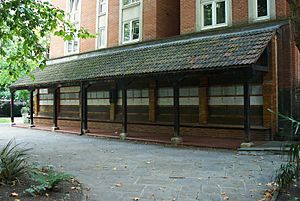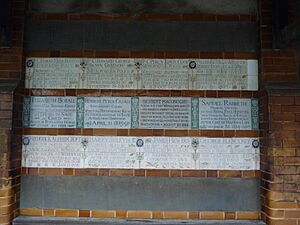Memorial to Heroic Self-Sacrifice facts for kids
The Memorial to Heroic Self-Sacrifice is a special monument in Postman's Park in the City of London. It remembers ordinary people who bravely gave their lives to save others. These heroes might have been forgotten if not for this memorial.
The idea for this memorial came from a painter named George Frederic Watts in 1887. He wanted to honor Queen Victoria during her Golden Jubilee. His idea wasn't used at first. But in 1898, a vicar named Henry Gamble asked Watts about it again. Postman's Park was built on the old churchyard of Gamble's church, St Botolph's Aldersgate. Gamble thought Watts's memorial would make the park more famous.
The memorial opened in 1900, but it wasn't finished. It had a 50-foot (15 m) wooden walkway called a loggia. This walkway sheltered a wall with space for 120 special ceramic tiles. These tiles were designed by William De Morgan. When it opened, only four tiles were in place. Watts passed away in 1904. His wife, Mary Watts, then took over the project.
In 1906, after making 24 tiles, William De Morgan stopped making ceramics to become a novelist. Only one company, Royal Doulton, could make the right kind of tiles after that. Mary Watts wasn't happy with Royal Doulton's designs. She was also busy managing the Watts Gallery and Watts Mortuary Chapel in Compton, Surrey. So, she lost interest in the project. Work on the memorial happened now and then, but it completely stopped in 1931. At that time, only 53 of the planned 120 tiles were on the wall.
In 2009, the Diocese of London allowed new tiles to be added. The first new tile in 78 years was put up. There was also a mobile app called The Everyday Heroes of Postman’s Park. It was released in 2013 but is no longer available. The app shared detailed stories about the 54 incidents remembered on the wall.
The Heroic Tablets
The memorial wall has space for five rows of tablets. Currently, there are tiles in three rows. The original 24 tiles by De Morgan are in the middle row. The 24 tiles added in 1908 are directly below them. Newer tiles are above the original ones. The first and fifth rows are still empty.
The first four tiles were installed in 1900. They were large and custom-made by De Morgan. Nine more De Morgan tiles were added in 1902. These were made from standard tiles to save money. These were the last tiles Watts saw installed. Eleven more De Morgan tiles were added in 1905, along with a special memorial to Watts himself. This completed the central row.
All 24 tiles in the fourth row were made by Royal Doulton and added in 1908. Later, a single Royal Doulton tile for PC Alfred Smith was added in 1919. In 1930, three more police officers were honored with similar tiles. A corrected tile for the East Ham Sewage Works incident was also added. In 1931, a tile in the original De Morgan style was added for schoolboy Herbert Maconoghu. This filled a gap in the center row. In 2009, a 54th tile was added for Leigh Pitt. This was the first new tile in 78 years!
Here are some of the incredible stories remembered on the tablets:
- Thomas Griffin (Died 1899): A fitter's laborer who was badly burned in a boiler explosion. He went back into the danger to find his friend and died.
- Walter Peart and Harry Dean (Died 1898): A train driver and fireman on the Windsor Express. They were scalded and burned but stayed to save the train and its passengers.
- Mary Rogers (Died 1899): A stewardess on the ship Stella. She gave her life belt to someone else and went down with the sinking ship.
- George Stephen Funnell (Died 1899): A police constable. During a fire, he saved two people. He then went back into the flames to save a barmaid, risking his own life.
- Alice Ayres (Died 1885): The daughter of a bricklayer's laborer. She bravely saved three children from a burning house but lost her own young life.
- David Selves (Died 1886): A 12-year-old boy. Near Woolwich, he held onto his drowning friend and sank with him, showing amazing loyalty.
- Henry James Bristow (Died 1890): An eight-year-old boy. He saved his little sister's life by tearing off her burning clothes. He caught fire himself and died from his injuries and shock.
- Leigh Pitt (Died 2007): A reprographic operator, aged 30. He saved a drowning boy from a canal but sadly could not save himself. This was the first new tablet added in 78 years.
In Other Media
The memorial has inspired artists and filmmakers.
- Susan Hiller's Monument (1980-81): This art project showed enlarged photos of 41 of the tablets. Viewers could sit on a bench and listen to the artist talk about death, memory, and heroism. This artwork is now part of the Tate art collection.
- Closer (2004 film): The tiles dedicated to Alice Ayres were an important part of the story in this movie.
- Woodpigeon's 'An Entanglement of Weeds' (2010 song): The Canadian band Woodpigeon (band) wrote this song after being inspired by the memorial. It mentions the story of David Selves.
Images for kids











